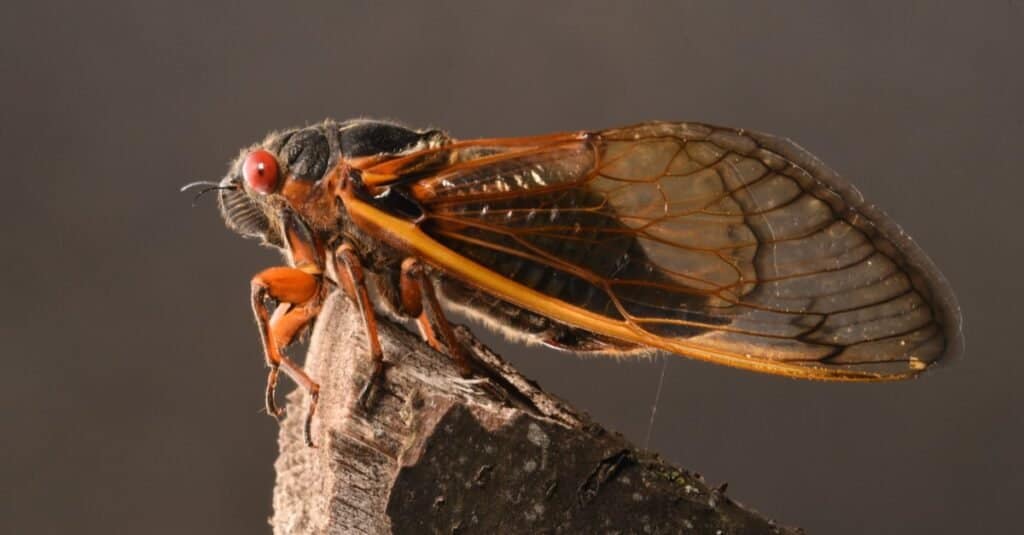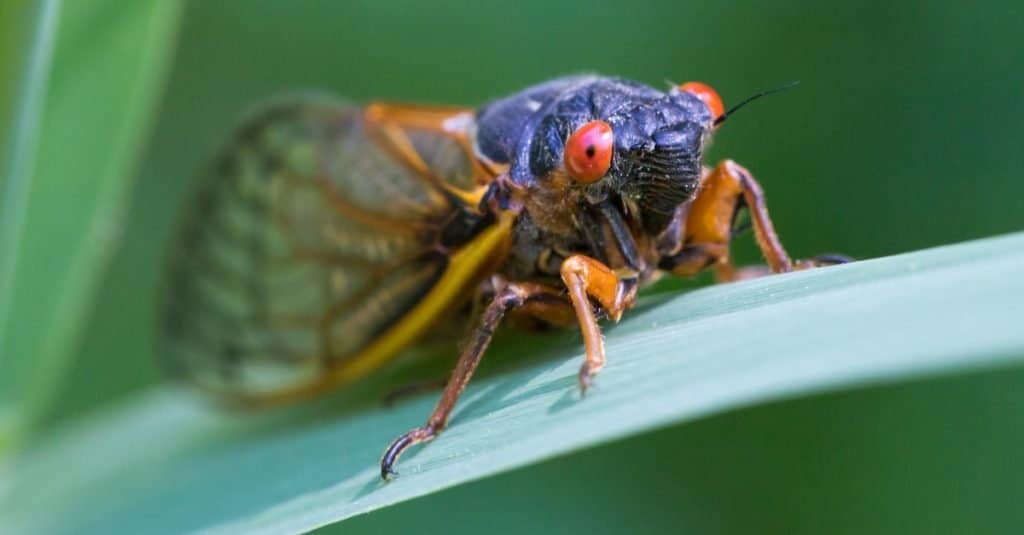Whenever summer is around the corner, certain nights get a lot louder, especially in the southern United States! There are thousands of species of insects that make noise, but generally, there are two that “sing” the loudest. Today, we are going to be learning about the difference between katydids and cicadas. These insects are both incredibly interesting and live in close proximity to humans. With that in mind, it can be helpful to know the difference between the two, especially as they keep you up at night! Let’s get started.
Comparing a katydid and a cicada

Katydids and cicadas are different in their appearance, their reproduction cycle, and their song.
©1979825168/Shutterstock.com
| Katydid | Cicada | |
| Appearance | Mostly green, some species can be pink or brown | Black or green, occasionally blue or red |
| Location and Range | Prefers tropical regions, can be found on every continent except Antarctica | Every continent except Antarctica. Prefers temperate climates |
| Song | High pitched, halting, staccato sounding | Rattling, screeching |
| Reproduction | Lays eggs on plant stems. Reproduces often | Depends on the species, usually lays eggs in the ground |
| Diet | Leaf eaters; occasionally eats other plant parts and dead or small insects | Sucks nutrients from plants and roots |
Key Differences Between a Katydid and a Cicada
The main differences between katydids and cicadas are their appearance (size and shape), their song, and their reproduction cycle.
When it comes to their appearance, katydids and cicadas have some similarities but can be easily differentiated. Katydids resemble grasshoppers and crickets, sometimes even being referred to as “bush crickets.” Cicadas are much more round and bulbous, looking more like an overgrown flea than anything.
Regarding their song, both are quite famous. Katydids have a high-pitched song that is halting and staccato-like. Cicadas are probably more easily identifiable with their screeching and clicking noises.
For their reproduction, katydids and cicadas are distinctly different. Katydids lay their eggs on the stems of plants, usually reproducing through the year, especially in warmer climates. Cicadas lay their eggs on trees, but the nymphs spend most of their lives deep underground before emerging to mate and quickly die. North American cicadas are known for their emergence from the ground en-masse, resulting in “broods” of cicadas that number in the billions.
Aside from those primary differences, there are some other unique qualities that both of these insects share. Let’s explore those differences, as well as a few others, in-depth.
Katydid Vs Cicada: Appearance

Katydids are generally brown or green while cicadas can be brown, green, blue, and red.
©iStock.com/ePhotocorp
Katydids can be quite variable in their appearance, especially with the number of species out there (2,000 just in the Amazon). Still, there are some similarities they all share. Katydids are related to grasshoppers and crickets and look almost identical to them, with the main difference being their longer antennae that stretch longer than their bodies. Most katydids are green, but some species come in brown, with some being famous for their bright pink color. They are experts at camouflage and can blend in well with their environments.
Cicadas are much easier to identify since there aren’t many insects that look quite like them. Cicadas are bulbous insects with large bulbous eyes and prominent, transparent wings. They come in a few colors, primarily brown and green. North American cicadas, known as periodical cicadas, can come in colors like blue and red.
Katydid Vs Cicada: Location and Range

Both katydids and cicadas live all over the world, but katydids are found on the ground and cicadas live in trees as adults.
©Elliotte Rusty Harold/Shutterstock.com
Katydids are incredibly far-ranging insects and are present on every continent save Antarctica. The most diverse area for katydid species is in tropical climates, namely in the Amazon rainforest, where there are 2,000 known species. Additionally, North America has upwards of 250 species, with thousands more worldwide. They generally prefer tropical regions, but they live in cool and temperate regions across the world.
Cicadas are also incredibly far-ranging insects. They also live on every continent save Antarctica, with over 3,000 species known and more reported but undocumented. Cicadas spend most of their lives in the ground as nymphs. Once they emerge, they are arboreal (they live in trees) for a few weeks before dying off. They prefer temperate regions, but can be found in all sorts of environments.
Katydid Vs Cicada: Song
While both species of insect can create loud songs (mating calls), they are distinctly different. Katydids sound much like their grasshopper and cricket cousins. They create their sound through sound-producing organs on their front wings. Through vibrating these organs, they can create loud noises, the frequency of which is generally dependent on the ambient temperature. Incredibly, the simple equation of (chirps per 15 seconds + 37) is an accurate way to tell the temperature in the United States (in Fahrenheit). Below is a recorded clip of a katydid song.
Cicadas are quite famous for their song, although it’s distinctly different from the katydid song. Cicadas use their song to find mates, just like katydids do. Where katydids use friction (a process called stridulation) to make their sounds, most cicadas use specialized organs called tymbals to produce theirs. Their abdomens can act as a soundbox, allowing the reverberations to travel further. Where there are different species of cicada present, they will occupy different heights on trees and vary the times that they call in order to make sure the right mates get to them. A cicada’s song is much raspier than a katydid, with some describing it as screeching. Take a listen below to hear a clip of a North American cicada call.
Katydid Vs Cicada: Reproduction

Katydids reproduce and lay eggs on plant stems. Cicadas have a lifecycle that can sometimes span 17 years.
©tienduc1103/Shutterstock.com
The difference between katydid and cicada reproduction is quite notable. Katydids use their song to find mates. Once they have found a mate, the male will give a gift to the female, something called a spermatophylax. The fluid is nutritious and used to distract the female with food while the male attaches his spermatophore to her. Once the process is completed, the female lays eggs near the stems of plants, where they will eventually hatch. After they hatch, they will go through a process of molting, maturing, and growing each time. Finally, they repeat the cycle themselves.
Cicadas have a distinct reproductive cycle that has resulted in human attention. When cicadas reproduce, they follow the same initial steps that most other insects do. After a male finds a mate through his song, they will mate and the female will lay eggs on a tree. Once they hatch, the nymphs will fall towards the ground and dig deep into the earth, where they will live for years at a time, feeding on root sap and juices. When it’s time to mate, they emerge from the ground, shed, and fly into the trees to repeat the process, dying soon after. North American cicadas have a unique adaptation, however, that sets them apart. Instead of individual cicadas emerging from the ground to mate, entire generations (known as broods) will emerge from the ground all at once. These emergences happen every 17 years and are noted due to the billions of loud, singing bugs that emerge all at once.
Bonus: Predatory Katydids Are Carnivores
The average katydid eats tiny insects to supplement its diet while relying on plants for nourishment. Predatory katydids of the species Saginae hunt and eat other insects – including other katydids. Along with the praying mantis – Saginae are fierce hunters of insects that they catch with their powerful, spiny legs. These giant insects also sport a spiny thorax to aid in holding and disemboweling their prey.
There are 45 subspecies of Saginae – with the largest being the Middle Eastern Saga ephippigera and the black-winged clonia taking second place. The black-winged clonia grows up to 9 inches (22 cm) and is one of the largest insects in southern Africa. It is also one of the loudest – a single male can be heard from about a mile away.
The photo featured at the top of this post is © Marcos Cesar Campis/Shutterstock.com
Thank you for reading! Have some feedback for us? Contact the AZ Animals editorial team.






